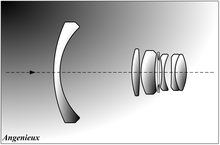Angénieux retrofocus
 | |
| Introduced in | 1950 (stills) |
|---|---|
| Author | Pierre Angénieux (1950) |
| Construction | 1 + (4..5) elements in 2 groups |
| Aperture | f/2.5 |
The Angénieux retrofocus photographic lens is a wide-angle lens design that uses an inverted telephoto configuration. The popularity of this lens design made the name retrofocus synonymous with this type of lens. The Angénieux retrofocus for still cameras was introduced in France in 1950 by Pierre Angénieux.
The telephoto lens configuration combines positive and negative lens groups with the positive at the front, so as to reduce the back focal distance of the lens (the distance between the back of the lens and the image plane) to a figure shorter than the focal length. This is for practical, not for optical reasons, but rather because telephoto lenses can then be made shorter and less cumbersome.
The inverted telephoto configuration does the reverse, employing one or more negative lens groups at the front to increase the back focal distance of the lens – possibly to a figure greater than the focal length – in order to allow for additional optical or mechanical parts to fit behind the lens.
The inverted telephoto design was first employed in the 1930s by Taylor-Hobson for the early Technicolor "3-strip" cameras since the beam splitter unit behind the lens required significant space, so that a long back focal distance was essential. Also, wide-angle lenses for narrow-gauge movie cameras had to be of this type because of the shutter mechanism that had to fit in between.
In still photography, a single-lens reflex camera requires a space for the reflex mirror, imposing a limit on the use of wide-angle lenses of normal designs. The retrofocus lens addressed this situation by shifting the focal plane further back, thus making wider-angle lenses usable while retaining normal viewing and focusing. Unless the reflex mirror were locked in the "up" position, blacking out the viewfinder, the rearmost element of a non-retrofocal lens would be in the way as the mirror flipped up and down during exposure.
Made in focal lengths of 24 mm, 28 mm, and 35 mm, the Angénieux retrofocus lens inspired other lens makers to produce wide-angle lenses of this type for almost every 35mm SLR, and helped to make it the definitive camera type of the late 20th century.
References
- Paul Gates. "An introduction to Angenieux lenses". (broken link)
- Bruce Sirovich. "Retrofocus Design Problems: A Synopsis". (broken link)